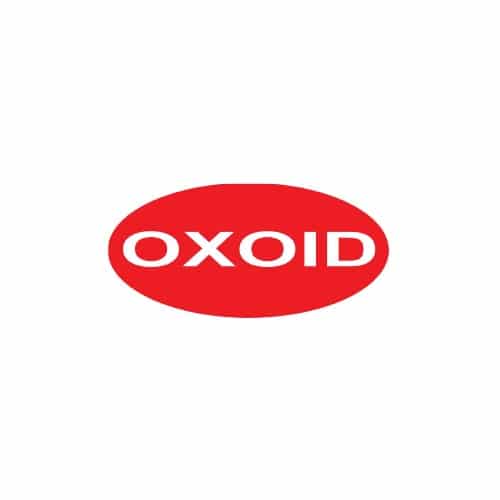
Potassium Lactate 50%
RM372.00Brand:
Thermo ScientificTM OxoidTM
Thermo Scientific™ Oxoid Potassium Lactate is a solution for addition to culture media, Lysine Medium CM0191 for example.
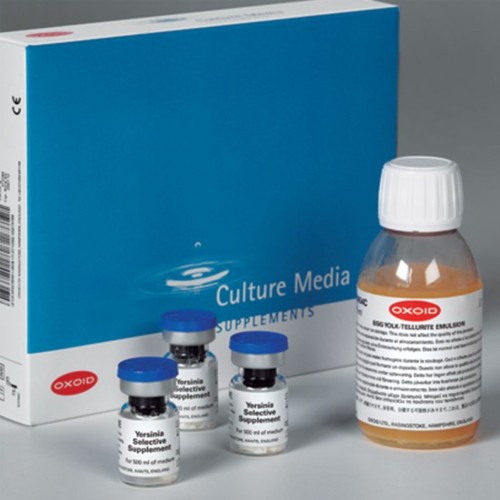
Potassium Tellurite 3.5%
RM319.00Brand:
Thermo ScientificTM OxoidTM
Oxoid Potassium Tellurite (3.5%) is a solution for addition to culture media.
Ordering Information:
Supplied 2mL/vial
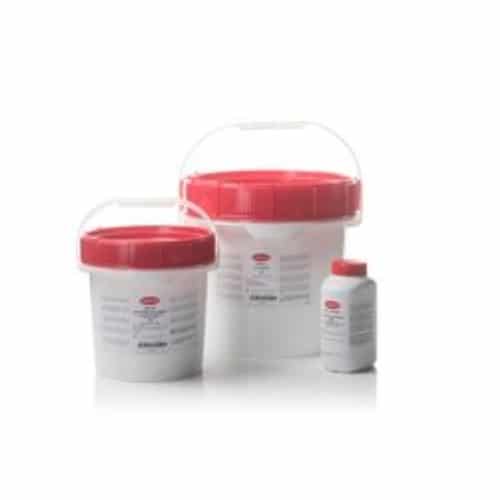
Potato Dextrose Agar 500g, Oxoid
RM253.00Brand:
Thermo ScientificTM OxoidTM
Isolate and enumerate yeasts and molds from dairy and food products and prepare Aspergillus niger for the Harmonised Microbial Limit Tests from international pharmacopoeia with Thermo Scientific™ Oxoid™ Potato Dextrose Agar (Dehydrated). This medium is suitable for the detection and enumeration of heat resistant molds in thermally processed fruits and fruit products.
Pigment production is a critical part of the identification of the fungus. The agar used in the medium is carefully screened to ensure correct pigment production by fungi such as Fusaria spp.
Composition of Potato Dextrose Agar
| Typical Formula * | gm/litre |
| Potato Extract | 4.0 |
| Glucose | 20.0 |
| Agar | 15.0 |
| pH 5.6 ± 0.2 @ 25°C |
Preparation of Potato Dextrose Agar, Oxoid
Suspend 39g in 1 litre of purified water and heat up to dissolve completely. Sterilise by autoclaving at 121°C for 15 minutes. Ensure the solution is well mixed before pouring.
To suppress the growth of bacteria, you can acidify the medium to pH 3.5 by adding 1 ml of lactic acid 10% SR0021 to each sterilized medium at 50°C. Note that the medium must not be heated after the addition of acid as it will destroy the gelling properties and results in hydrolysis of agar.
Storage Conditions and Shelf Life
Store the dehydrated medium at 10-30°C and use before the expiry date on the label.
Store the prepared medium at 2-8°C.
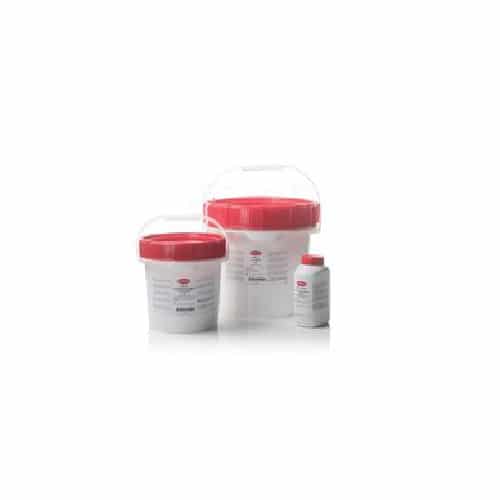
Potato Dextrose Broth 500g
RM314.00Brand:
Thermo ScientificTM OxoidTM
Thermo Scientific™ Oxoid Potato Dextrose Broth is a general broth for yeasts and molds.

Pre-Supplemented DG18 (ISO) Agar
RM1,208.00Brand:
Thermo ScientificTM OxoidTM
Isolate and enumerate yeasts and molds associated with food spoilage with Thermo Scientific™ Oxoid™ Pre-supplemented Dichloran-Glycerol 18% (DG18) (ISO) Agar Base (Dehydrated) while adhering to BS ISO 21527-2: 2008. Due to the presence of antibiotic Chloramphenicol in the formulation, the medium provides selectivity against bacteria as well as reducing harmful chemical handling in the laboratory.
Pre-supplemented Dichloran-Glycerol 18% (DG18) (ISO) Agar Base (Dehydrated), Oxoid Composition
| Typical Formula* | gm/litre |
| Casein Enzymatic digest | 5.0 |
| Glucose | 10.0 |
| Potassium dihydrogen phosphate | 1.0 |
| Magnesium sulphate | 0.5 |
| Dichloran (2,6-dichloro-4-nitroaniline) | 0.002 |
| Agar | 15 |
| Chloramphenicol | 0.1 |
| pH 5.6 ± 0.2 @ 25°C |
Pre-supplemented Dichloran-Glycerol 18% (DG18) (ISO) Agar Base, Oxoid Preparation:
Suspend 15.8g per 500ml (31.6g/l) of distilled water and heat to dissolve completely. Before autoclaving add 220g of Glycerol per 1 litre of medium. Heat the complete solution gently to aid its dissolution of the glycerol. This has been found to be a key procedure to follow to allow proper dissolution of the glycerol. Sterilize by autoclaving at 121°C for 15 minutes. Cool to 50°C, mix well and pour into sterile Petri dishes.
Where bacterial overgrowth occurs from certain foods (raw meats) chlortetracycline hydrochloride at 50mg/L (dissolved in water and filter sterilised) is recommended.
Storage instructions
Store the dehydrated medium at 10–30°C and use before the expiry date.
Precautions
The dichloran compound used in this medium is Botran® 2,6-Dichloro-4-Nitro-Analine (CAS: 99-30-9).
Pre-supplemented DG18 (ISO) Agar (CM1151) contains Chloramphenicol in the base powder and is therefore considered a toxic compound which should be handled in accordance with good industrial hygiene and safety practice. Always consult the MSDS before handling the powder.

Pre-Supplemented DRBC (ISO) Agar
RM1,131.00Brand:
Thermo ScientificTM OxoidTM
Isolate and enumerate yeasts and molds associated with food spoilage with Thermo Scientific™ Oxoid™ Pre-supplemented Dichloran Rose-Bengal Chloramphenicol (DRBC) (ISO) Agar Base (Dehydrated) while adhering to ISO 21527-1: 2008. Due to the presence of antibiotic Chloramphenicol in the formulation, the medium provides selectivity against bacteria as well as reducing harmful chemical handling in the laboratory.
Pre-supplemented Dichloran Rose-Bengal Chloramphenicol (DRBC) (ISO) Agar Base (Dehydrated), Oxoid Composition
| Typical Formula* | gm/litre |
| Peptone | 5.0 |
| Glucose | 10.0 |
| Potassium dihydrogen phosphate | 1.0 |
| Magnesium sulphate | 0.5 |
| Dichloran | 0.002 |
| Rose-bengal | 0.025 |
| Agar | 15.0 |
| Chloramphenicol | 0.1 |
| pH 5.6 ± 0.2 @ 25°C |
Pre-supplemented Dichloran Rose-Bengal Chloramphenicol (DRBC) (ISO) Agar, Oxoid Preparation:
Suspend 15.75g per 500ml (31.5g/l) of distilled water and heat to dissolve completely. Sterilize by autoclaving at 121°C for 15 minutes. Cool to 50°C, mix well and pour into sterile Petri dishes. It is advised to dispense the powdered medium into containers under an extraction hood due to the chloramphenicol in the medium base.
Storage instructions
Store the dehydrated medium at 10–30°C and use before the expiry date
Precautions
ROSE-BENGAL PHOTO-OXIDIZES TO FORM TOXIC COMPOUNDS. STORE PLATES OF THE MEDIUM IN THE DARK AND AVOID EXPOSURE TO LIGHT.
Some strains of fungi may be inhibited on this medium.
The dichloran compound used in this medium is Botran® 2,6-Dichloro-4-Nitro-Analine (CAS: 99-30-9).
Pre-supplemented DRBC (ISO) Agar (CM1149) contains Chloramphenicol in the base powder and is therefore considered a toxic compound which should be handled in accordance with good industrial hygiene and safety practice. Always consult the MSDS before handling the powder.

Preston Campylobacter Selective Supplement 1 x 10 Vials
RM0.00Brand:
Thermo ScientificTM OxoidTM
This product has been discontinued. The recommended alternative is Modified Preston Campylobacter Supplement, SR0204E.
Oxoid Preston Campylobacter Selective Supplement is used for the isolation of Campylobacter jejuni and Campylobacter coli from human, animal, avian, and environmental samples.
- Add to Campylobacter Agar Base, Part No. CM0689B or Nutrient Broth No. 2, Part No. CM0067B
- Each vial supplements 500mL of medium
Preston Campylobacter Selective Supplement, Oxoid Composition
| Vial contents (each vial is sufficient for 500ml of medium) | per vial | per litre |
| Polymyxin B | 2,500IU | 5,000IU |
| Rifampicin | 5.0mg | 10.0mg |
| Trimethoprim | 5.0mg | 10.0mg |
| Cycloheximide | 50.0mg | 100.0mg |
Preston Campylobacter Selective Agar, Oxoid Preparation:
Suspend 18.5g of Campylobacter Agar Base in 475ml of distilled water and bring to the boil to dissolve completely. Sterilise by autoclaving at 121°C for 15 minutes. Cool to 50°C. Aseptically add 25ml of Lysed Horse Blood (SR0048), and 1 vial of Preston Campylobacter Selective Supplement (SR0117 or SR0204) reconstituted as directed and one vial of Campylobacter Growth Supplement (SR0232). Mix well and pour into sterile Petri dishes.
Preston Campylobacter Selective Enrichment Broth, Oxoid Preparation:
Dissolve 12.5g of Nutrient Broth No.2 (CM0067) in 475ml of distilled water and sterilise by autoclaving at 121°C for 15 minutes. Cool to 50°C or below. Aseptically add 25ml of Lysed Horse Blood (SR0048), 1 vial of Preston Campylobacter Selective Supplement (SR0117 or SR0204) and 1 vial of Campylobacter Growth Supplement (SR0232). Aseptically dispense 5ml volumes in sterile small screw-capped bottles. The Selective Enrichment Broth may be stored for up to 7 days at 2-8°C.
Storage conditions and Shelf life
Store the dehydrated medium at 10-30°C and use before the expiry date on the label.
Store the prepared plates at 2-8°C.
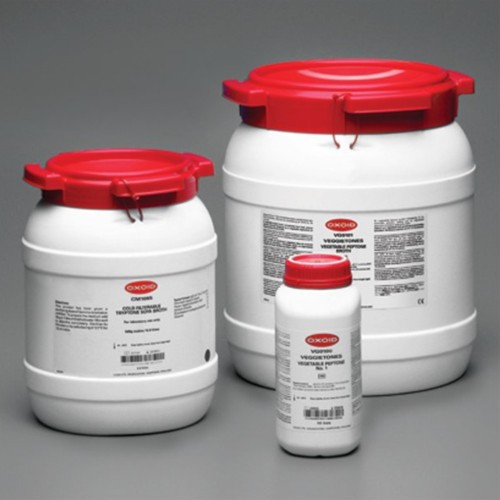
Proteose Peptone 500g
RM594.00Brand:
Thermo ScientificTM OxoidTM
Oxoid Proteose Peptone is a speciality peptone containing proteoses as defined in the USP.
- Particularly suitable for use in toxin production and in culture media for bacteria with wide-ranging nutritional requirements

Pseudomonas Agar Base 500g
RM444.00Brand:
Thermo ScientificTM OxoidTM
Selectively isolate Pseudomonas species from a range of samples with Thermo Scientific™ Oxoid™ Pseudomonas Agar Base (Dehydrated). The medium is modification of King’s A Medium and contains magnesium chloride and potassium sulphate for improved pigment production and recovery of Pseudomonas aeruginosa while strongly suppressing Klebsiella, Proteus and Providencia spp.
Pseudomonas Agar Base (Dehydrated), Oxoid Composition
| Typical Formula* | gm/litre |
| Gelatin peptone | 16.0 |
| Casein hydrolysate | 10.0 |
| Potassium sulphate | 10.0 |
| Magnesium chloride | 1.4 |
| Agar | 11.0 |
| pH 7.1 ± 0.2 @ 25°C |
Agar Preparation:
To Prepare the Agar Base:
Suspend 24.2g of the agar base, in 500ml of distilled water. Add 5ml of glycerol. Bring to the boil to dissolve completely, sterilise by autoclaving at 121°C for 15 minutes. Allow the medium to cool to 50°C.
To Prepare Pseudomonas CN Agar:
To 500ml of agar base cooled to 50°C add the contents of 1 vial of Pseudomonas CN Supplement (SR0102) rehydrated as directed. Mix well and pour into sterile Petri dishes.
To Prepare Pseudomonas CFC Agar:
To 500ml of agar base cooled to 50°C add the contents of 1 vial of Pseudomonas CFC Supplement (SR0103) rehydrated as directed. Mix well and pour into sterile Petri dishes.
Storage conditions and Shelf life
Store the dehydrated medium at 10-30°C and use before the expiry date on the label.
Store the prepared medium at 2-8°C.
Precautions
Fresh media should be prepared as required. Molten agar should not be kept longer than 4 hours. Medium should not be stored and remelted. If swarming colonies of Proteus species are a problem in food samples then the incubation temperature can be lowered to 20°C for a period of 3-5 days. Chilled foods may carry a wide range of pseudomonads and the colonies on CFC Medium, incubated at lower temperatures, may be Pseudomonas fluorescens or Pseudomonas putida as well as Pseudomonas aeruginosa. Aeromonas species will also appear as pink/brown colonies, particularly from fish products.

Pseudomonas C-F-C Selective Supplement 1 x 10 Vials
RM372.00Brand:
Thermo ScientificTM OxoidTM
Oxoid C-F-C Supplement is used for the isolation of Pseudomonas species.
- Add to to Pseudomonas Agar Base, Part No. CM0559B
- Each vial supplements 500mL of medium
Pseudomonas CFC Supplement, Oxoid Composition
| Vial contents (each vial is sufficient for 500ml of medium | per vial | per litre |
| Cetrimide | 5.0mg | 10.0mg |
| Fucidin | 5.0mg | 10.0mg |
| Cephalosporin | 25.0mg | 50.0mg |
Pseudomonas CFC Agar, Oxoid Preparation:
To 500ml of agar base cooled to 50°C add the contents of 1 vial of Pseudomonas CFC Supplement (SR0103) rehydrated as directed. Mix well and pour into sterile Petri dishes.
Storage conditions and Shelf life
Store the dehydrated medium at 10-30°C and use before the expiry date on the label.
Store the prepared medium at 2-8°C.
Precautions
Fresh media should be prepared as required. Molten agar should not be kept longer than 4 hours. Medium should not be stored and remelted. If swarming colonies of Proteus species are a problem in food samples then the incubation temperature can be lowered to 20°C for a period of 3-5 days. Chilled foods may carry a wide range of pseudomonads and the colonies on CFC Medium, incubated at lower temperatures, may be Pseudomonas fluorescens or Pseudomonas putida as well as Pseudomonas aeruginosa. Aeromonas species will also appear as pink/brown colonies, particularly from fish products.

Pseudomonas C-N Selective Supplement 1 x 10 Vials
RM367.00Brand:
Thermo ScientificTM OxoidTM
Oxoid C-N Supplement is used for the isolation of Pseudomonas aeruginosa.
- Add to to Pseudomonas Agar Base, Part No. CM0559B
- Each vial supplements 500mL of medium
Pseudomonas CN Supplement, Oxoid Composition
| Vial contents (each vial is sufficient for 500ml of medium) | per vial | per litre |
| Cetrimide | 100.0mg | 200.0mg |
| Sodium nalidixate | 7.5mg | 15.0mg |
Pseudomonas CN Agar, Oxoid Preparation:
To 500ml of agar base cooled to 50°C add the contents of 1 vial of Pseudomonas CN Supplement (SR0102) rehydrated as directed. Mix well and pour into sterile Petri dishes.
Storage conditions and Shelf life
Store the dehydrated medium at 10-30°C and use before the expiry date on the label.
Store the prepared medium at 2-8°C.
Precautions
Fresh media should be prepared as required. Molten agar should not be kept longer than 4 hours. Medium should not be stored and remelted. If swarming colonies of Proteus species are a problem in food samples then the incubation temperature can be lowered to 20°C for a period of 3-5 days. Chilled foods may carry a wide range of pseudomonads and the colonies on CFC Medium, incubated at lower temperatures, may be Pseudomonas fluorescens or Pseudomonas putida as well as Pseudomonas aeruginosa. Aeromonas species will also appear as pink/brown colonies, particularly from fish products.

Pseudomonas Cetrimide Agar (Usp-Ep) 500g
RM485.00Brand:
Thermo ScientificTM OxoidTM
Selectively isolate and differentiate Pseudomonas aeruginosa from a range of samples using Thermo Scientific™ Oxoid™ Cetrimide Agar (USP, EP) (Dehydrated). The medium contains magnesium chloride and potassium sulphate for improved pigment production and recovery of Pseudomonas aeruginosa while strongly suppressing Klebsiella, Proteus and Providencia spp. The medium conforms to European Pharmacopoeia for Microbial Limit Tests.
Cetrimide Agar (USP, EP) (Dehydrated), Oxoid Composition
Typical Formula* | gm/litre |
| Gelatin peptone | 20.0 |
| Magnesium Chloride | 1.4 |
| Potassium Sulphate | 10.0 |
| Cetrimide | 0.3 |
| Agar | 13.6 |
| Final pH 7.2 ± 0.2 @ 25°C |
Cetrimide Agar Preparation:
Suspend 45.3g of Pseudomonas Cetrimide Agar in 1 litre of distilled water. Add 10ml of glycerol and boil to dissolve completely. Sterilize by autoclaving at 121°C for 15 minutes. Cool the medium to approximately 50°C and pour into sterile Petri dishes.
Storage conditions and Shelf life
Store the dehydrated medium at 10-30°C and use before the expiry date on the label.
Store the prepared plates at 2-8°C.

Purified Agar 500g
RM1,026.00Brand:
Thermo ScientificTM OxoidTM
Oxoid Purified Agar is an exceptionally bright and clear agar recommended for electrophoresis studies but also suitable for many bacteriological purposes.

R.P.F. Supplement, Oxoid
RM3,915.00Brand:
Thermo ScientificTM OxoidTM
Oxoid RPF Supplement (Rabbit Plasma Fibrinogen) is used for the isolation and enumeration of coagulase positive staphylococci from food.
- Use only with Baird-Parker Agar Base, RPF, Part No. CM0961B
- Each vial supplements 100mL of medium
RPF Supplement (Rabbit Plasma Fibrinogen), Oxoid Composition
| Vial contents (each vial is sufficient for 100ml of medium) | |
| Fibrinogen | 0.375 g |
| Rabbit plasma | 2.5 ml |
| Trypsin inhibitor | 2.5 mg |
| Potassium tellurite | 2.5 mg |
RPF Supplement Medium Preparation:
Reconstitute one vial as directed, aseptically add the contents to 90 ml of sterile Baird-Parker Agar Base (RPF) CM0961 cooled to 48°C. Mix well and use immediately.
Precautions
Colonies of some contaminating organisms growing in close proximity to the coagulase positive colonies may partially digest the coagulase halo reaction.

R2A Agar 500g
RM478.00Brand:
Thermo ScientificTM OxoidTM
Enumerate heterotrophic bacteria from drinking water samples with Thermo Scientific™ Oxoid™ R2A Agar (Dehydrated). This nutritionally reduced medium was specially designed to enhance the recovery of stressed and chlorine damaged bacteria from treated water samples. Stressed or injured organisms during water treatment are unable to grow on high nutrient media since faster-growing organisms outgrow the former. Therefore the use of a low nutrient medium like R2A Agar incubated for longer incubation periods allows these stressed organisms to grow well.
R2A Agar, Oxoid Composition
| Typical Formula* | gm/litre |
| Yeast extract | 0.5 |
| Proteose peptone | 0.5 |
| Casein hydrolysate | 0.5 |
| Glucose | 0.5 |
| Starch | 0.5 |
| Di-potassium phosphate | 0.3 |
| Magnesium sulphate | 0.024 |
| Sodium pyruvate | 0.3 |
| Agar | 15.0 |
| pH 7.2 ± 0.2 @ 25°C |
R2A Agar, Oxoid Preparation:
Suspend 18.1g in 1 litre of distilled water. Bring to the boil to dissolve completely. Sterilise by autoclaving at 121°C for 15 minutes. Mix well and pour into sterile Petri dishes.
Storage conditions and Shelf life
R2A Agar should be stored tightly capped in the original container at 10-30°C. When stored as directed the medium will remain stable until the expiry date printed on the label.
The prepared medium may be stored for up to 2 weeks at 2-8°C.

Raka-Ray Medium 500g
RM884.00Brand:
Thermo ScientificTM OxoidTM
- Oxoid Raka-Ray Agar Base is a medium for the isolation of lactic acid bacteria in beer and brewing processes.
- Requires supplementation with phenylethanol, sorbitan mono-oleate, and cycloheximide Part No. SR0222C.
Raka-Ray Agar Base, Oxoid Composition
| Typical Formula* | gm/litre |
| Yeast extract | 5.0 |
| Tryptone | 20.0 |
| Liver concentrate | 1.0 |
| Maltose | 10.0 |
| Fructose | 5.0 |
| Glucose | 5.0 |
| Betaine HCL | 2.0 |
| Diammonium hydrogen-citrate | 2.0 |
| L-Aspartic acid† | 2.5 |
| L-Glutamic acid†† | 2.5 |
| Magnesium sulphate. 7H2O | 2.0 |
| Manganese (II) sulphate. 4H2O | 0.66 |
| Potassium phosphate | 2.0 |
| N-Acetyl glucosamine | 0.5 |
| Agar | 17.0 |
| pH 5.4 ± 0.2 @ 25°C |
Raka-Ray Agar, Oxoid Preparation:
Suspend 77.1g in 1 litre of distilled water. Add 10ml of sorbitan mono-oleate and 7ml of 0.1% Cycloheximide Solution (SR0222). Sterilise by autoclaving at 121°C for 15 minutes. Cool to 50-55°C and aseptically add 3g of phenylethanol. Pour into sterile Petri dishes or distribute into 4ml volumes held at 55°C if the overlay technique is to be used.
Storage conditions and Shelf life
Store the dehydrated medium at 10-30°C and use before the expiry date on the label.
Store the prepared medium at 2-8°C.
Precautions
Although the concentration of cycloheximide in the medium is below toxic levels, precautions should be observed as detailed under HAZARDS section.

Rappaport Vassiliadis Soy Peptone 500g
RM363.00Brand:
Thermo ScientificTM OxoidTM
Selectively enrich Salmonella spp. from food and environmental specimens with Thermo Scientific™ Oxoid™ Rappaport-Vassiliadis Soya Peptone Broth (Dehydrated). Rappaport- Vassiliadis Soya Peptone Broth selects for Salmonella species by exploiting their characteristics when compared with other Enterobacteriaceae, such as the ability to survive at relatively high osmotic pressure, multiply at relatively low pH values, be relatively more resistant to malachite green, and have relatively less demanding nutritional requirements.
Rappaport-Vassiliadis Soya Peptone Broth (Dehydrated), Oxoid Composition
| Typical Formula* | gm/litre |
| Soya peptone | 4.5 |
| Sodium chloride | 7.2 |
| Potassium dihydrogen phosphate | 1.26 |
| Di-potassium hydrogen phosphate | 0.18 |
| Magnesium chloride (anhydrous) | 13.58 |
| Malachite green | 0.036 |
| pH 5.2 ± 0.2 @ 25°C |
Rappaport-Vassiliadis Soya Peptone Broth (Dehydrated), Oxoid Preparation:
Suspend 26.75g in 1 litre of distilled water and heat gently to dissolve. Dispense 10ml volumes into screw-capped bottles or tubes and sterilise by autoclaving at 115°C for 15 minutes.
Storage conditions and Shelf life
Store the dehydrated medium at 10-30°C and use before the expiry date on the label.
Store the prepared medium at 2-8°C.
Precautions
RVS Broth should not be used if Salmonella Typhi is suspected.
In order to achieve optimum recovery it is recommended that the enrichment broth is incubated at 42 ± 1°C.

Rappaport-Vassiliadis (RV) Broth 500g
RM309.00Brand:
Thermo ScientificTM OxoidTM
Selectively enrich Salmonella spp. from food and environmental specimens with Thermo Scientific™ Oxoid™ Rappaport-Vassiliadis Enrichment Broth (Dehydrated). Rappaport-Vassiliadis Enrichment Broth selects for Salmonella species by exploiting their characteristics when compared with other Enterobacteriaceae, such as the ability to survive at relatively high osmotic pressure, multiply at relatively low pH values, be relatively more resistant to malachite green, and have relatively less demanding nutritional requirements.
Rappaport-Vassiliadis Enrichment Broth (Dehydrated), Oxoid Composition
| Typical Formula* (Classical) | gm/litre |
| Soya peptone | 5.0 |
| Sodium chloride | 8.0 |
| Potassium dihydrogen phosphate | 1.6 |
| Magnesium chloride 6H2O | 40.0 |
| Malachite green | 0.04 |
| pH 5.2 ± 0.2 @ 25°C |
THIS MEDIUM IS VERY HYGROSCOPIC AND MUST BE PROTECTED FROM MOISTURE.
The quantities given for the formula as classically described made 1110ml of medium. They have been published this way in the Oxoid literature to coincide with the scientific literature.
The directions for reconstituting Oxoid Rappaport-Vassiliadis (RV) Enrichment Broth follow usual Oxoid practice and specify the weight needed for 1 litre of medium.
Rappaport-Vassiliadis Enrichment Broth (Dehydrated), Oxoid Preparation:
Add 30g (the equivalent weight of dehydrated medium per litre) to 1 litre of distilled water. Heat gently until dissolved completely. Dispense 10ml volumes into screw-capped bottles or tubes and sterilise by autoclaving at 115°C for 15 minutes.
Storage conditions and Shelf life
Store the dehydrated medium at 10-30°C and use before the expiry date on the label.
Store the prepared medium at 2-8°C.
Precautions
RV Broth should not be used if Salmonella typhi is suspected.
Note the difference in weight between the classical formula on the label and the reduced weight per litre, using anhydrous magnesium chloride.

Reinforced Clostridial Agar 500g
RM572.00Brand:
Thermo ScientificTM OxoidTM
Cultivate and enumerate anaerobes, especially Clostridium species, with Thermo Scientific™ Oxoid™ Reinforced Clostridial Agar (RC Agar) (Dehydrated). A solid, highly nutritious medium, it can be used as an enrichment medium to optimize the growth of clostridia and other anaerobes, lactobacilli, and many other species of bacteria.
Reinforced Clostridial Agar (RC Agar) (Dehydrated), Oxoid Composition
| Typical Formula* | gm/litre |
| Yeast extract | 3.0 |
| `Lab-Lemco’ powder | 10.0 |
| Peptone | 10.0 |
| Glucose | 5.0 |
| Soluble starch | 1.0 |
| Sodium chloride | 5.0 |
| Sodium acetate | 3.0 |
| Cysteine hydrochloride | 0.5 |
| Agar | 15.0 |
| pH 6.8 ± 0.2 @ 25°C |
Reinforced Clostridial Agar (RC Agar) (Dehydrated), Oxoid Preparation:
Suspend 52.5g in 1 litre of distilled water. Bring to the boil to dissolve completely. Sterilise by autoclaving at 121°C for 15 minutes.
Storage conditions and Shelf life
Store the dehydrated medium at 10-30°C and use before the expiry date on the label.
Store the prepared medium at 2-8°C.
Precautions
Further identification tests must be carried out on organisms isolated from this medium.

Reinforced Clostridial Medium 500g
RM520.00Brand:
Thermo ScientificTM OxoidTM
Cultivate and enumerate clostridia and other anaerobes occurring in food and pathological samples with Thermo Scientific™ Oxoid™ Reinforced Clostridial Medium. A semi-solid, highly nutritious medium can be used as an enrichment medium to optimize the growth of clostridia before sub-culturing to solid agar.
Reinforced Clostridial Medium, Oxoid Composition
| Typical Formula* | gm/litre |
| Yeast extract | 13.0 |
| Peptone | 10.0 |
| Glucose | 5.0 |
| Soluble starch | 1.0 |
| Sodium chloride | 5.0 |
| Sodium acetate | 3.0 |
| Cysteine hydrochloride | 0.5 |
| Agar | 0.5 |
| pH 6.8 ± 0.2 |
Reinforced Clostridial Medium, Oxoid Preparation:
Suspend 38 g in 1 litre of distilled water. Bring to the boil to dissolve completely. Sterilise by autoclaving at 121°C for 15 minutes.
Storage conditions and Shelf life
Store the dehydrated medium at 10-30°C and use before the expiry date on the label.
Store the prepared medium at 2-8°C.

Ringers Solution Tablets (100’s)
RM0.00Brand:
Thermo ScientificTM OxoidTM
Oxoid Ringers Solution Tablets is used for the preparation of isotonic diluents for bacterial cells and bacteriological specimens.
Each tablet prepares 500mL solution. For Laboratory Use Only.
Ringers Solution Tablets, Oxoid Composition
| Formula | gm/litre |
| Sodium chloride | 2.25 |
| Potassium chloride | 0.105 |
| Calcium chloride 6H2O | 0.12 |
| Sodium bicarbonate 0.05 | 0.05 |
| pH |
One tablet makes 500 ml of quarter-strength Ringers solution.
Ringers Solution Preparation:
To prepare quarter-strength Ringers Solution, dissolve 1 tablet in 500ml of distilled water. Sterilise by autoclaving at 121°C for 15 minutes.

Rose Bengal Chloramphenicol Agar 500g
RM570.00Brand:
Thermo ScientificTM OxoidTM
- Oxoid Rose-Bengal Chloramphenicol Agar Base is a medium for the selective enumeration of yeast and molds from foods.
- Also available Chloramphenicol Selective Supplement, Part No. SR0078E.
Rose-Bengal Chloramphenicol Agar Base, Oxoid Composition
| Typical Formula* | gm/litre |
| Mycological peptone | 5.0 |
| Glucose | 10.0 |
| Dipotassium phosphate | 1.0 |
| Magnesium sulphate | 0.5 |
| Rose-Bengal | 0.05 |
| Agar | 15.5 |
| pH 7.2 ± 0.2 @ 25°C |
Rose-Bengal Chloramphenicol Agar, Oxoid Preparation:
Suspend 16.0g per 500ml (32.0g/l) of distilled water and bring to the boil to dissolve completely. Reconstitute one vial SR0078E per 500ml medium or one vial SR0078H per 2 litres medium, as directed. Add the vial contents to Rose Bengal Chloramphenicol Agar Base (CM0549) and mix gently. Autoclave at 121°C for 5 minutes. Cool to 50°C, mix gently and pour into Petri dishes.
Storage conditions and Shelf life
Store the dehydrated medium at 10-30°C and use before the expiry date on the label.
Store the prepared medium at 2-8°C away from light.
NB: Rose-Bengal photo-oxidises to form toxic compounds. Store plates of the medium in the dark and avoid exposure to light.
Precautions
It is essential to store plates of media containing Rose-Bengal in the dark to prevent toxic photo-oxidation of the dye. See above.
Identify moulds and yeasts by morphological appearance and microscopic examination. Colonies of bacteria and yeasts can be confused.

S S Agar (Modified) 500g
RM662.00Brand:
Thermo ScientificTM OxoidTM
Oxoid SS Agar Modified (Salmonella Shigella Agar Modified) is used for the isolation of Salmonella species and Shigella spp.
Salmonella Shigella Agar Modified, Oxoid Composition
| Typical Formula* | gm/litre |
| `Lab-Lemco’ powder | 5.0 |
| Peptone | 5.0 |
| Lactose | 10.0 |
| Bile salts | 5.5 |
| Sodium citrate | 10.0 |
| Sodium thiosulphate | 8.5 |
| Ferric citrate | 1.0 |
| Brilliant green | 0.00033 |
| Neutral red | 0.025 |
| Agar | 12.0 |
| pH 7.3 ± 0.2 @ 25°C |
Salmonella Shigella Agar Modified, Oxoid Preparation:
Suspend 57g in 1 litre of distilled water. Bring to the boil with frequent agitation, and allow to simmer gently to dissolve the agar. DO NOT AUTOCLAVE. Cool to about 50°C mix well and pour into sterile Petri dishes.
Storage conditions and Shelf life
Store the dehydrated medium at 10-30°C and use before the expiry date on the label.
Store the prepared medium at 2-8°C.

S S Agar 500g
RM457.00Brand:
Thermo ScientificTM OxoidTM
Isolate and identify Salmonella and Shigella species from clinical or food samples with Thermo Scientific™ Oxoid™ SS Agar (Dehydrated). Differentiation of Salmonella and Shigella is achieved by incorporation of lactose in the medium. Organisms which ferment lactose produce acid which, in the presence of the neutral red indicator, results in the formation of red colonies. Salmonella, Shigella, and other non-lactose-fermenting organisms appear as transparent or straw coloured colonies on SS Agar.
SS Agar, Oxoid Composition
| Typical Formula* | gm/litre |
| `Lab-Lemco’ powder | 5.0 |
| Peptone | 5.0 |
| Lactose | 10.0 |
| Bile salts | 8.5 |
| Sodium citrate | 10.0 |
| Sodium thiosulphate | 8.5 |
| Ferric citrate | 1.0 |
| Brilliant green | 0.00033 |
| Neutral red | 0.025 |
| Agar | 15.0 |
| pH 7.0 ± 0.2 @ 25°C |
SS Agar, Oxoid Preparation:
Suspend 63g in 1 litre of distilled water. Bring to the boil with frequent agitation and allow to simmer gently to dissolve the agar. DO NOT AUTOCLAVE. Cool to about 50°C, mix and pour into sterile Petri dishes.
Storage conditions and Shelf life
Store the dehydrated medium at 10-30°C and use before the expiry date on the label.
Store the prepared medium at 2-8°C.
Precautions
This medium is highly selective and R-strains of shigellae will not grow on it. It is not recommended for the primary isolation of shigellae.



